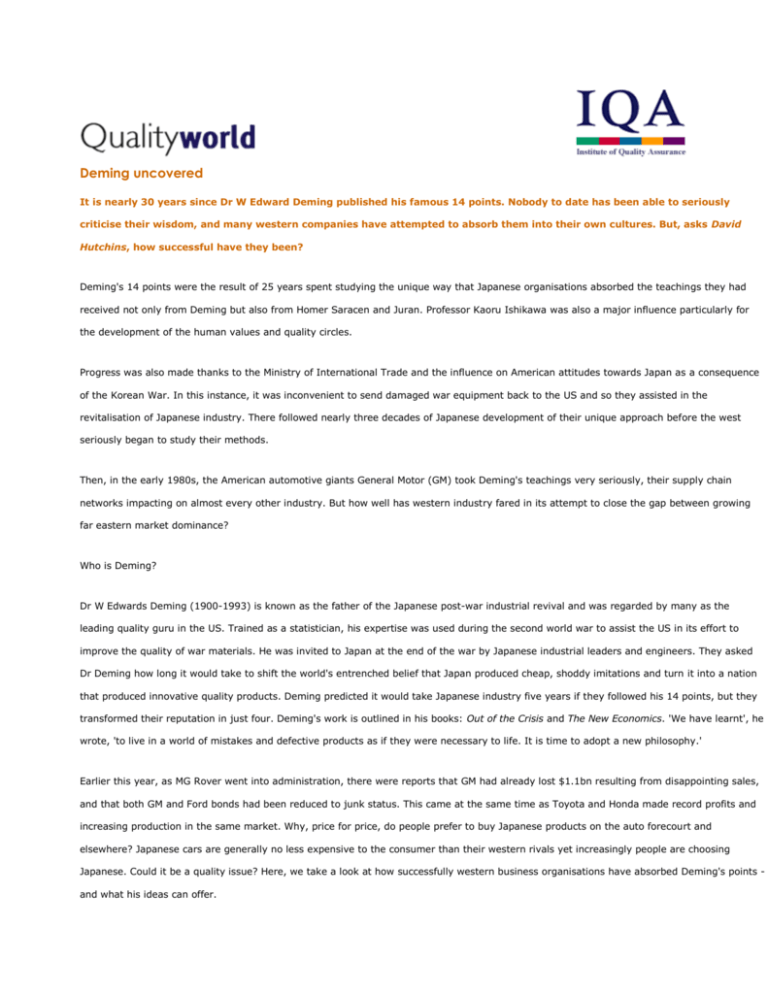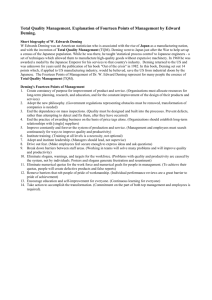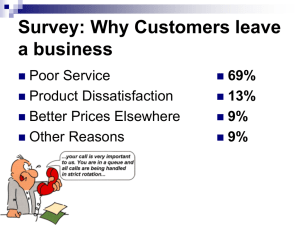
Deming uncovered
It is nearly 30 years since Dr W Edward Deming published his famous 14 points. Nobody to date has been able to seriously
criticise their wisdom, and many western companies have attempted to absorb them into their own cultures. But, asks David
Hutchins, how successful have they been?
Deming's 14 points were the result of 25 years spent studying the unique way that Japanese organisations absorbed the teachings they had
received not only from Deming but also from Homer Saracen and Juran. Professor Kaoru Ishikawa was also a major influence particularly for
the development of the human values and quality circles.
Progress was also made thanks to the Ministry of International Trade and the influence on American attitudes towards Japan as a consequence
of the Korean War. In this instance, it was inconvenient to send damaged war equipment back to the US and so they assisted in the
revitalisation of Japanese industry. There followed nearly three decades of Japanese development of their unique approach before the west
seriously began to study their methods.
Then, in the early 1980s, the American automotive giants General Motor (GM) took Deming's teachings very seriously, their supply chain
networks impacting on almost every other industry. But how well has western industry fared in its attempt to close the gap between growing
far eastern market dominance?
Who is Deming?
Dr W Edwards Deming (1900-1993) is known as the father of the Japanese post-war industrial revival and was regarded by many as the
leading quality guru in the US. Trained as a statistician, his expertise was used during the second world war to assist the US in its effort to
improve the quality of war materials. He was invited to Japan at the end of the war by Japanese industrial leaders and engineers. They asked
Dr Deming how long it would take to shift the world's entrenched belief that Japan produced cheap, shoddy imitations and turn it into a nation
that produced innovative quality products. Deming predicted it would take Japanese industry five years if they followed his 14 points, but they
transformed their reputation in just four. Deming's work is outlined in his books: Out of the Crisis and The New Economics. 'We have learnt', he
wrote, 'to live in a world of mistakes and defective products as if they were necessary to life. It is time to adopt a new philosophy.'
Earlier this year, as MG Rover went into administration, there were reports that GM had already lost $1.1bn resulting from disappointing sales,
and that both GM and Ford bonds had been reduced to junk status. This came at the same time as Toyota and Honda made record profits and
increasing production in the same market. Why, price for price, do people prefer to buy Japanese products on the auto forecourt and
elsewhere? Japanese cars are generally no less expensive to the consumer than their western rivals yet increasingly people are choosing
Japanese. Could it be a quality issue? Here, we take a look at how successfully western business organisations have absorbed Deming's points and what his ideas can offer.
1
'Create constancy of purpose toward improvement of product and service, with the aim of becoming competitive and staying in business, and
providing jobs.'
GM and Ford embraced this point: Ford conducted an intensive study of Toyota and its partner Mazda in the late 1970s and returned to
announce their 'AJ policy' (after Japan). Through this it immediately began to flatten their hierarchy, introduced self-maintenance and statistical
process control. Since then it has published the Ford Q101 quality system standard as a management business improvement guide for its
suppliers, in an effort to emulate Toyota supplier performance. This led to QS 9000 being jointly published by GM, Ford and Chrysler which has
recently been developed into TS 16949. Ford has also seriously attempted to implement lean principles.
All of this implies constancy of purpose for nearly 30 years in these cases. However, constancy of purpose seems to have been less well applied
in other western companies: MG Rover and a host of others have switched from one'panacea' to another. It often seems that many western
companies make dramatic positive changes when trouble beckons but then revert back to their old ways when the threat recedes. In contrast,
the mentality of Japanese companies is to keep moving forward and striving for constant improvement.
2
'Adopt the new philosophy. We are in a new economic age. Western management must awaken to the challenge, learn their responsibilities and
take on leadership for change.'
Of all of the 14 points this is the least understood, and unfortunately many of the subsequent points depend on it. This philosophy is based
upon a fundamental belief in the potentially unlimited creativity of the individual at all levels of organisations. In the words of Professor
Ishikawa:'To display human capabilities and eventually draw out infinite possibilities'. This philosophy is rigorously applied from the top right
through to the line people.
Another fundamental is the observation that each individual is the expert in his or her own job. Through this, the objective will be:'To create an
organisation in which the creativity and job knowledge of every individual is working towards the goals of the organisation. By definition,
managers do not make anything - managers get results through people. Everything in the new philosophy is focused on the development of
people and this extends right through the supply chain. To understand this philosophy properly it is necessary to study it in action. Many
Japanese companies in the west apply this, eg Toyota in Derby, Nissan in Washington and Honda in Swindon. The British managers who are
responsible for this spent months in training on the production lines in parent companies in Japan.
3
'Cease dependence on inspection to achieve quality. Eliminate the need for inspection on a mass basis by building quality into the product.'It
does not matter how much you inspect a bad product, it will not make it any better. All you can hope to do is separate good from bad, and
inspectors themselves are fallible. All inspection does is to add cost - it is better to make it right in the first place. Many western companies
have recognised the futility of using inspection as a means of improving quality but very few appear to have effective alternatives. Preproduction planning is often skimped in order to obtain prior franchise with the consequence that production methods are not optimised.
Statistical process control is used for control but not for pre-production diagnostics. Consequently, new products go into production with far
more'special causes' inherent in their processes than might otherwise be the case. There have been many examples where even prototype
testing has been shortcut with the result that products have been returned for repair which include parts that are not even on the parts list. A
typical Japanese company and even some in the west will practise concurrent design where potential production problems are identified and
eliminated before whole-scale production is commenced.
4
'End the practice of awarding business on the basis of price tag. Instead, minimise total cost. Move toward a single supplier for any one item,
on a long-term relationship of loyalty and trust.'
It seems to have taken a long time for the relevance of this key point to sink in but today most large organisations are attempting to
implement it by developing partnerships and long term collaborative arrangements with a small number of suppliers. Companies such as
Philips, GE and Motorola have elaborate supply quality schemes where they work closely with a smaller number of suppliers. In the case of all
of these companies, they provide six sigma training for the benefit of their preferred suppliers.
In Toyota this is known as'the Toyota family'. This will probably accelerate too as more companies turn their backs on third party assessment
organisations and opt for more reliable second party evaluation. Such companies realise that it is dangerous to leave the control of their supply
chains to independent third party organisations because they are not sufficiently aware of the specific requirements of each customer. In fact it
is this recognition that led the so called'big three' automotive manufacturers to develop QS 9000 in the first place.
5
'Improve constantly and forever the system of production and service, to improve quality and productivity, and thus constantly decrease costs.'
Most western managers still believe that better quality costs more. We still have to move mountains to convince people that if we concentrate
on the'quality of the way that we do things', quality will improve and costs will go down. In Japan they say'look after the process and the
product will look after itself.'
The problem results from a confusion as to the meaning of the word'quality'. If it is taken to mean the difference between plastic and gold
plated bath taps then it is clear that the gold plated taps are more expensive and some would say, better quality. However, if fitness for use is
taken into account, then the plastic taps might be better in a public convenience, especially if the taps can be stolen.
If, on the other hand, we have two companies both making either the plastic or the gold taps, then the one with the best quality production
methods will be more predictable and the costs likely to be lower. The main means by which these costs can be dramatically reduced is through
vigorous project-by-project improvement.
6
'Institute training on the job.'
Western industry does not appreciate the importance of this or indeed the hidden value of multi-skilling. In Japan multi-skilling is often referred
to as 'horizontal promotion'. Most of these schemes are under the direct control of the line supervisor who is tasked to continually widen the
range of skills of his subordinates. The ideal would be for everyone to be able to perform all of the tasks. This gives considerable flexibility while
giving the worker the satisfaction of knowing that he or she is recognised and treated with respect.
Traditionally, in the west, training is usually carried out by specialist trainers. In contrast, whilst this also occurs in the'new philosophy', training
on the job is conducted not only by the supervisor, as part of her personal development, but also by the individual's peer group. This is not only
an effective form of people development but also helps to develop the responsibilities and role of the supervisor and increases the maturity of
the relevant work group.
7
'Institute leadership. The aim of supervision should be to help people and machines and gadgets to do a better job. Supervision of management
is in need of overhaul, as well as supervision of production workers.'
We still do not seem to have learned that managers get results through people. The role of management is not to make anything themselves
but to give appropriate support to those that do. In a sense, in the 'new philosophy', the manager's role is largely 'facilitation' of the work of
their subordinates and to widen their range of skills. Therefore if the workers or lower levels of management achieve high levels of
performance, then the upper levels are also congratulated for making it possible. The difficulties again root back to the problems related to the
second point. In the west a manager is expected to look busy and does so by concealing information from his subordinates in order to look
important. In contrast, a Japanese manager will have time on his hands which he uses to further develop his workers. In fact, it is a fairly
widespread principle in Japanese management that a manager cannot be promoted until it is clear that he has trained his successor. This
principle applies all the way to the top.
8
'Drive out fear, so that everyone may work effectively for the company.'
Deming had in mind the fear of being blamed when things go wrong. Our natural reaction to a disaster of any kind is 'whose fault was it?' The
vast majority of us go to work to do a quality job. If something inadvertently goes wrong it therefore makes sense to investigate the
circumstances that caused it to prevent it happening again. We should attack problems, not people. The west tends to have a blame culture,
and this is often well illustrated when a national disaster occurs, and the press attempts to point the finger of blame at the individual.
9
'Break down barriers between departments. People in research, design, sales and production must work as a team, to foresee problems of
production and in use that may be encountered with the product or service.'
ISO 9001 may be helping this point, and to a slightly lesser extent the excellence awards, but on the whole silo management is still very much
in evidence in western industry. Usually attempts to implement so-called'matrix management' are so complicated and confusing that eventually
people revert back to silo management.
It has not been fully researched, but the problem is probably largely due to insecurity. In a blame culture, managers get promoted based on
their apparent ability. In many cases this is often because they cover themselves when things do go wrong. Since this applies to other
managers as well it means that they move up to a better class of competition.
This in turn leads to the need to develop defensive skills which they do. As a consequence they are very sceptical about any proposals for
change until they have answered the question: 'Will this threaten my position?'
Multi-function six sigma teams are helping to some extent because the methods used concentrate on the organisational issues and do not
threaten people. Often the causes are found to be on the boundaries between operations and therefore blame is not normally a factor. By
working together this way, the individuals begin to appreciate each other's jobs and problems they face.
10
'Eliminate slogans, exhortations and targets asking for zero defects and new levels of productivity. Most causes of low quality/productivity
belong to the system and lie beyond the workforce's power.'
In the 1970s, UK companies were plastered with posters encouraging workers to 'take more care'. Since then society has progressed in
eliminating slogans. The second part of this point is generally not well understood. It relates to a situation prevalent in the 1970s where most
workers were paid directly for the quantity of units they produced in a given time almost irrespective of their quality. This practice, thankfully,
isn't commonplace any more.
Direct payment by results has largely disappeared and therefore it is easier to convince the worker that quality is just as important as quantity.
Also, through the activities of quality circles, kaizen, root cause analysis and project story boards, it is easier to convince people of the need for
continuous improvement.
11
'Remove barriers that deprive hourly workers of their right to pride of workmanship. The responsibility of supervisors must be changed from
sheer numbers to quality.'
While some progress has been made here, the west still has a very long way to go. In the east this is done largely through the support of
management from groups such as quality circles or'gemba kaizen' (workshop improvement). A quality circle is a small group of workers doing
the same or similar work who meet together on a regular basis in work time and are trained to identify, analyse and solve work-related
problems and present their solutions to their manager.
Kaizen works in much the same way since it is an alternative term originally preferred by Nissan. In the east, the numbers of quality circles
have grown steadily - there are more than 20 million in China. Quality circles appeared to have taken off in the UK, the US and parts of Europe
in the late 1970s and early 1980s. Unfortunately, the implementation was often ill-conceived and the concept's reputation was damaged by bad
press.
12
'Remove barriers that rob people in management and engineering of their right to pride of workmanship. This means abolishing the annual or
merit rating and of management by objective.'
Management by objectives is a concept developed by the UK management scientist John Humble in the 1970s, where top teams of managers
set formal business objectives which were then cascaded down to lower levels. It was a popular concept in the west when Deming wrote his
book. Unfortunately at that time both total quality and what the Japanese describe as 'hoshin kanri' (similar to 'management by objectives' but
focused on vision and mission), were largely unknown in the west.
13
'Institute a vigorous program of education and self-improvement.'
Professor Ishikawa often said: 'Quality begins and ends with education.' What is still not appreciated in the west is the amount of qualityrelated training that Japanese companies give to upper management. The belief is that, despite six sigma, quality is a factory-based shop floor
activity. In Japan, China and most other far eastern countries, quality is integral to the role of top management. Until top management really
begins to believe that 'quality' in its broadest sense is fundamental to survival then we will never even begin to satisfy this point.
14
'Put everybody in the company to work to accomplish the transformation. The transformation is everybody's job.'
This requires quality to be higher up the western business agenda and implemented from the top down. Much of what is available as a quick fix
is already out in the marketplace, eg six sigma, balanced scorecards, benchmarking or lean manufacture. But these will not change the overall
culture. We could learn a lot by studying the development of Deming-inspired programmes like the Toyota production system. What are we
waiting for?
David Hutchins can be contacted on e: david@hutchins.co.uk. Visit his consultancy DHI on www.hutchins.co.uk
The Institute of Quality Assurance, 12 Grosvenor Crescent, London SW1X 7EE
Telephone: +44 (0)20 7245 6722
Fax: +44 (0)20 7245 6755
e-mail: iqa@iqa.org
©2002 IQA. All Rights Reserved









